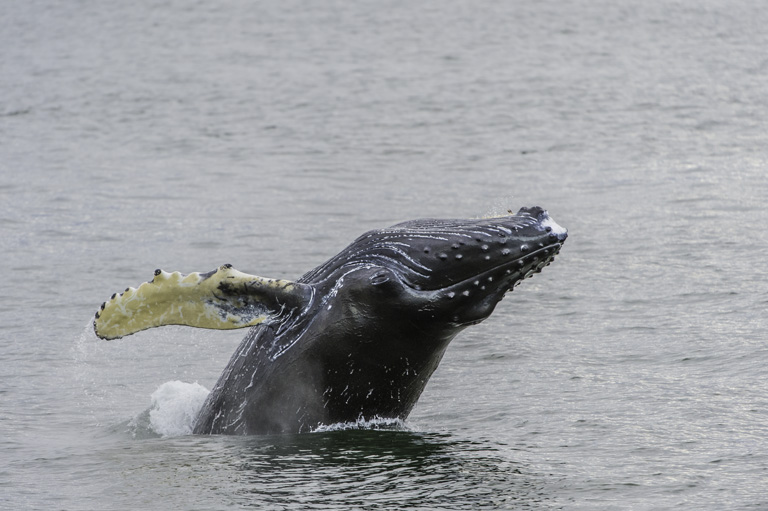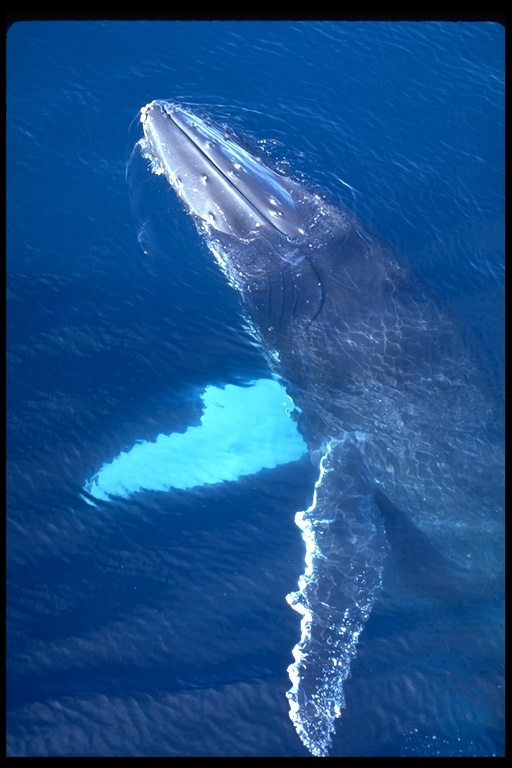
(Photo: Gerald and Buff Corsi © California Academy of Sciences)
STATUS
Federal: Endangered Endangered (Central America DPS) & Threatened (Mexico DPS)
POPULATION TREND
= Stable
RESTORATION
Difficult
FAMILY
Balaenopteridae, a group of baleen whales
RANGE
Nearly global (two distinct population segments occur off the California coast)
Appearance
The humpback whale ranges in length from 12–16 meters. It has long side fins and a characteristically knobby head, which is covered in tubercles (hair follicles, also found on its fins).
Habitat & Behavior
The humpback whales that occur near California migrate seasonally between summer feeding grounds and tropical winter mating and calving areas. These whales are members of the Mexico (Endangered) and Central America (Threatened) distinct population segments. The Mexican population breeds along the Pacific coast of Mexico, the Baja California Peninsula, and the Revillagigedos Islands, and feeds across a broad range from California to the Aleutian Islands (Alaska). The Central American population breeds along the Pacific coast of Costa Rica, Panama, Guatemala, El Salvador, Honduras, and Nicaragua and feeds almost exclusively off California and Oregon. The whales feed on anchovies, sardines, and krill.
The vocalizations of humpback whales are well known – males humpback whales sing complex songs lasting 10 to 20 minutes, which they repeat for hours at a time.
Threats
Though commercial hunting of humpback whales is now largely prohibited, ongoing threats include entanglement in fishing gear, ship strikes, disturbance from low-frequency noise, and overfishing, which impacts their food sources.
Conservation
NOAA is actively working to reduce entanglements and ship strikes through a network of programs (here is one example). Marine protected areas are also an effective way to protect important habitat, such as the seasonal feeding grounds to which the whales routinely return. Long-term monitoring of populations and continued study also allow scientists to better understand how humpback whale population patterns and responses to change.
About This Map
This map is based on summer and fall sightings of humpback whales. The sightings were recorded during ship surveys and used to build a habitat model that shows approximate whale density, or the number of individual animals that scientists have predicted should occur per square kilometer of ocean. Only the Western U.S. portion of the whale’s distribution is shown here. The model was developed by Dr. Elizabeth Becker and her team (a link to her paper and the data is under Data Sources below).
Where can you spot it?
Humpback whales occur off the coast of Los Angeles from April to December.

Data source: Humpback whale habitat based density model from Becker et al. (2016) in Remote Sensing, 8(2), accessed via CetSound
Acknowledgements: We would like to thank Elizabeth Becker for generously sharing the humpback whale distribution data.
References: